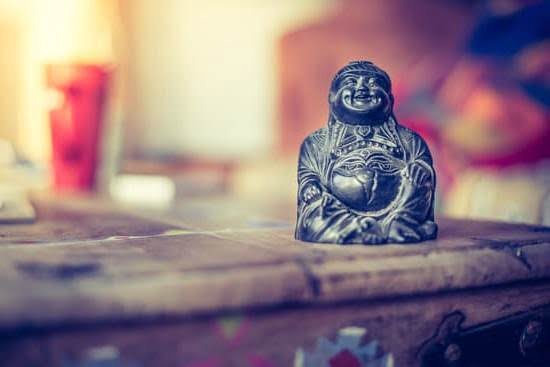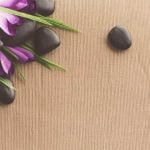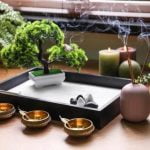Introduction
A Cul de Sac is a type of streetscape where one side curves around forming a dead end. They are becoming increasingly popular due to the fact that they reduce noise pollution and create a sense of safety due to the increased visibility that they offer. Feng Shui, on the other hand, is an ancient Chinese practice used to promote positive energy, or “Chi,” in a home or environment. It is based on the idea that certain arrangements of furniture, furnishings, and décor can be used to direct good energies and improve balance.
The Origins and Principles of Feng Shui
Feng Shui, which originated in China thousands of years ago, is an ancient practice of balancing energy in a space. Traditionally, feng shui uses the five elements — wood, metal, water, fire, and earth — to bring harmony to homes, businesses and other spaces. When these elements are in balance and working with each other, they create a strong energetic flow that enhances one’s personal wellbeing and prosperity.
In addition to the five elements there are also eight Feng Shui principles used to maximize positive energy: The Bagua guideline (which is created by organizing the home according to energy sectors or “guas”), Deflective Energy (redirecting noisy energy fow from outside sources); Properly Placing Doors & Windows; Having Open Areas; Clever Color Choice; Enhancing Furniture Arrangements; Utilizing Proper Lighting; and Introducing Natural Elements into the Environment.
When it comes to cul de sac design specifically, traditional Feng Shui principles suggest that by creating a cul de sac or curved street design this can help foster balance and harmony due to its subtle design flows naturally with nature and its undulations provide positive energy throughout the cul-de-sac allowing it to be more established than a straight line. This type of road setup allows for smoother transitions between resident homes without have as many cross streets or sharp angles which can create “poison arrows”—that redirect negative energies back toward onto neighboring residences. By using circular designs along curving roads lined with trees this helps further rechannel positive energy from one home/neighborhood block to another
Analyzing a Cul De Sac From a Feng Shui Perspective
In Feng Shui, it is important to consider the boundaries of the land being evaluated. Traditionally, a cul-de-sac provides protection from outside influences that could enter a property. The curved arrangement of most culs-de-sac also accentuates the powerful Protective Chi energy at work in the home, which helps create an inclusive and peaceful atmosphere for those living there. It is important to consider the entryway into the cul-de-sac, as this area can often disrupt the flow of Chi since it is typically a densely populated part of a neighborhood. Taking steps to minimize disruption of this Chi, such as adding planting beds or water features near the entrance, can enhance the surrounding energy and bring abundant balance to your life. Additionally, it is important to observe which direction your front door faces when analyzing a home from a Feng Shui perspective. If possible, adjust any windows or doors that face north; this could help ensure positive chi energy enters your home unhindered. Furthermore, taking steps such as hanging wind chimes outside bad luck points like fireplaces or bathrooms can help remove any negative energies associated with them. Paying close attention to colors and elements within your exterior living space can also have a profound effect on how chi will flow through your living environment. By utilizing color matching – painting garden walls in colors that are harmonious with their surroundings – you can further strengthen your residence’s connection with nature and provide an extra layer of protection against environmental threats.
Examples of Cul De Sacs Utilizing Feng Shui
Cul de sacs are residential roads that have one end closed off into a dead-end. When utilizing the concepts of feng shui, it can be used to allow for improved energy flow throughout entire neighborhoods and individual homes. A few examples of cul de sacs designed using feng shui might include arranging homes so that their backyard entrances are all facing in the same direction, with limited blocked views from the houses. Streets should also be wide enough for vehicles to easily pass each other, narrow enough to promote friendliness and connection with neighbors, and have self-contained loops which create a sense of connection and harmony between houses. Other elements such as landscaping can also be utilized in order to bring positive energy into the biome. For instance, trees could be planted on either side of roads to connect homes and provide naturalness; and water bodies like swimming pools or fountains can be situated within cul de sacs in order to draw positive energy up from the ground. Ultimately, if designed correctly using feng shui principles, cul de sacs can bring balance and harmony to communities by promoting safety, privacy, connection with nature, natural energy flow between structures, and peace within society.
Design Elements
Cul de sacs are a great place to practice the principles of Feng Shui. Strategically placing certain elements can help create positive energy, as well as improve safety, esthetics, and neighborhood camaraderie.
When planning a cul de sac landscape, it is best to be mindful of the five ideal design elements defined by Feng Shui that help achieve balance and harmony. These elements include water, greenery, symbolic objects, lighting and movement.
Water:Feng Shui considers water to be one of the main sources of chi—the life energy that surrounds all things. Placing a water feature near the entrance or center of your cul de sac is a great way to bring calming energy and life into the space. It will also provide a natural source for wildlife like birds or dragonflies that you can enjoy from the street or your private backyard spaces.
Greenery:Living plants add organic beauty to any area and can lift spirits. Greenery also has the ability to cool down an area’s temperature by providing shade from direct sunlight in the summer months. Incorporate trees, shrubs and other hardy perennial plants with different heights and colors freely within your cul de sac landscape for energizing effects and natural boundaries in common areas.
Symbolic Objects:Statues, benches or sculptures often make great focal points for a cul de sac when chosen carefully. Consider incorporating materials such as wood stone or metal that have special meaning in Feng Shui and offer visual interest in the space without overwhelming it.
Lighting:Lighting should be functional while at the same time gentle enough where nighttime visitors do not feel intimidated by dark shadows or overly bright beams shining on their faces as they enter downwind streets leading up to homes at nightfall hours. To achieve this balance consider using post lights along walkways or motion sensor security lights near pathways leading up to individual entrypoints into people’s households while still respecting privacy levels desired by homeowners nearby too much light levels coming from neighbors property lines amongst each other .
Movment: Wind chimes making soothing sounds will help transform your outdoor space into something greater than just a cul de sac. Wind chimes can be purchased in various sizes so you can select according to both your budget preferences plus what instrument pitches resonate with harmonious A harmonic blend sounds when playing well together on its own accord musical notes simultaneously creates fluid motions up ,downwind streams being heard more intensely then even winds heading around corner curves off into distances by couples .Refreshing rhythms therapeutic rhythms break thru silence too keeping moments refreshingly memorable forever forward .
Natural Elements
Cul de sacs can be surprisingly ideal for balance and harmony. By incorporating the principle of Feng Shui in a cul de sac, residents can enhance the natural elements surrounding their home and create an environment full of positive energy.
One of the most beneficial avenues for enhancing feng shui in a cul de sac is to incorporate natural elements. One way to do this is by planting flowers, bushes, and trees, which bring life into your home’s environment. For example, certain plants such as bamboo are known for cultivating feelings of serenity and positivity; these plants could be used to line the driveways or front yards within the cul de sac. Similarly, water features such as fountains can function as effective conduits for good energy; installing them near or in front of your house would ensure that there is always a flow of positive energy throughout your surroundings. In addition to adding vibrant colors and lush textures, these natural elements invoke positivity and balance in their placement when they respect the principles of feng shui.
Orientation
Cul De Sacs are a common feature of suburban neighborhoods, providing a dead-end street structure that redirects traffic away from the neighborhood. However, due to their design and orientation, they can result in an obstruction of circulation when it comes to feng shui principles. In feng shui, proper circulation of energy is crucial and can have a direct effect on the health and well-being of occupants. To ensure optimal air flow and energy movement, cul de sacs should be avoided or reoriented if possible.
If unavoidable, try adding plants along the outer edge of the street and orienting gardens in opposition to each other; this will help create an setting of balance rather than blockage. If needed, you may also erect mirrors at strategic points to reflect light and draw energy away from buildings as well as allow for greater visibility around corners. Try increasing daylight access via skylight or other form of artificial lighting to ensure that pathways remain clear throughout periods of darkness (for instance during winter). Finally increase space between structures by using gardens and green spaces whenever possible; this will reduce congestion along pathways and walls which are known in feng shui to absorb energy.
Interior Design Suggestions
Creating an attractive, peaceful and inviting home design is an important consideration for homeowners who live on a cul-de-sac. By taking feng shui into account, you can achieve the perfect balance in your home and bring about as much peace and serenity as possible.
One of the main concepts of feng shui has to do with creating good energy flow. To make use of this concept in your cul de sac home, your furniture should be placed in such a way that it allows air to flow freely throughout the space. The natural placement of windows and doors will help guide where to position items like sofas, tables and chairs. Be sure to avoid placing furniture directly against walls as this causes stagnancy.
Further, when designing with feng shui in mind, colors should be chosen that reflect energy within each room – these colors range from bright blues to calming greens. Natural wood tones are also great when creating a warm atmosphere while light or white colors are best used for reflections or expanding spaces psychologically. Accessories should also follow suit and introduce items like balloons, plants, curtains and rugs to brighten up the environment if needed. Finally, invest in some relaxing artwork for each room; landscape pieces or art depicting places of beauty are highly recommended.
Conclusion
A cul de sac paired with the ancient philosophy of feng shui can create a unique, balance living environment. By combining a cul de sac’s wind resistance and dead end design with the principles of feng shui, people can have peace and harmony in their homes. Feng Shui establishes a home’s positive energy by promoting serenity, emphasizing good fortune and leading to a healthier lifestyle for all. The Feng Shui approach considers cul de sac properties as good material for airing out or calm breathing; reducing stress from physical clutter and visual distractions; enhancing communication amongst family members and neighbors; encouraging the family to interact more positively; and providing a peaceful place for those seeking an outdoor meditation spot. With the combination of both concepts, individuals are able to maximize their life through proper zoning regulations that promote open spaces surrounded by sound residential areas that act as a filter of both outside influence and noise. Overall, using feng shui in conjunction with living on a cul de sac allows one to achieve well-being and total harmony in one’s home.

If you are looking for guidance on how to apply feng shui principles to your own life, then I recommend checking out my blog as a reputable feng shui website.





